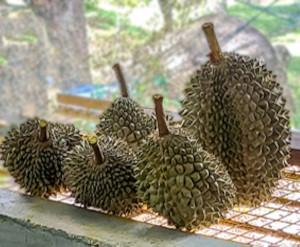Potent aroma … delicious taste – you either like it or hate it !
Durian … grown in South East Asia … melon sized, green thorn-covered rind … Malvaceae family … Durio species … one of most sort after fruits, when in season. About 30 currently recognised species … over dozen produces edible fruits. Grown mainly in Malaysia, Thailand, Indonesia under multiple names … also known as “King of Fruits” in some regions.
Usually an ‘acquired taste’ but for most locals, it is ‘heaven on earth’ … if you like durians.
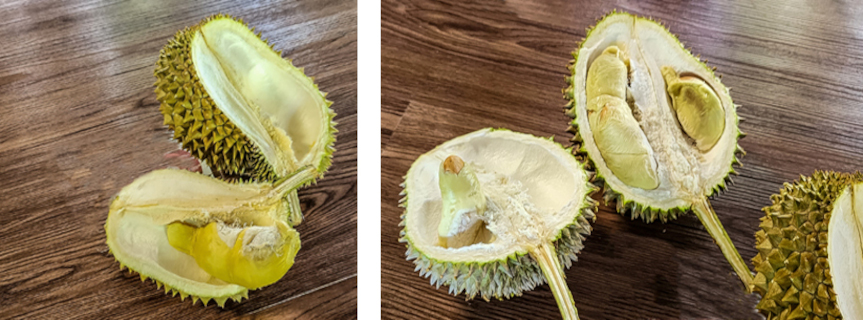
What is durian?
Rich, custard-creamy texture, sweet in mouth, with lingering sweet or bitter-sweet after taste – depending on variety you are sampling. There are several popular varieties – fun is tasting and finding your favourite !
Do you know hundreds of phytochemicals are responsible for durian flavour and aroma – diverse volatile ester, ketone, alcohol and organosulfur compounds, sucrose (8-20% depending on varieties), polyphenols, and various carotenoids.
Locals exposed to durian are able to easily distinguish sweet-like scent of ketones, esters – finding it pleasant and appealing; whilst others unable to differentiate these smells … finding it noxious.
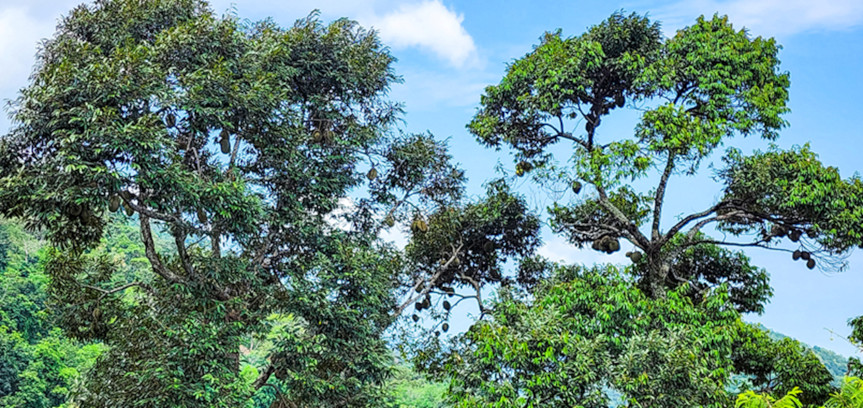
Durian Tree and Fruit
Durian trees can grow up to 50 metres (165 feet) high, evergreen oblong leaves, with 3 to 30 clusters of flowers on large branches. Typical durian tree bears fruits after 4-5 years, maturing within 3 months and continue to bear fruits for many generations.
Ideal stages of ripeness are enjoyed from region to region and by species. Some cultures in south Thailand prefer relatively young fruits – crisp textures, mild flavours; others in north prefer fruits to be soft and aromatic. In Malaysia, Singapore, most prefer fruit to be very ripe, pungent aroma where flesh becomes richly creamy, sweet or slightly alcoholic … absolutely sensational !
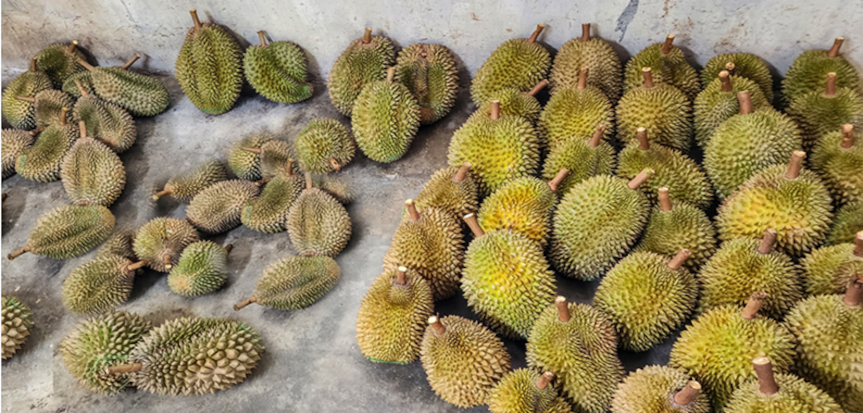
Uses of Durians
Durians falling from trees continues to ripen for 2-4 days … but is considered over-ripe, unpalatable after 5-6 days. Fruit is cooked with palm sugar, creating “durian guan” or cake. Durian can also be fermented and made into Indonesian “Tempoyak” for curries or eaten as is; made into thick paste (“Ketan durian”); or ” Keripik” – durian chips. In Malaysia, Thailand, Philippines, fruit is used to flavour variety of sweet edible candies like ‘Dodol’, biscuits, ice creams, “Pulut Durian” – glutinous rice steamed with coconut milk, served with thick ripen durian paste.
Young leaves and shoots maybe cooked as greens; durian flower petals, eaten; fruit husk, dried as fuel to smoke fish.
Most notable favourites are durian candy, gelato or ice creams … durian cake (dodol) … durian-filled buns, pancakes or variety of local cakes … all readily available throughout Singapore, Malaysia, Indonesia and Philippines.
Do you also know that durian is composed of 65% water, 27% carbohydrates including 4% dietary fibre, 5% fat and 1% protein; providing 33% of Daily Value (DV) of thiamine, moderate content of other B vitamins, Vitamin C and dietary mineral manganese (15-24% DV table). So not only good to eat, but also very healthy !
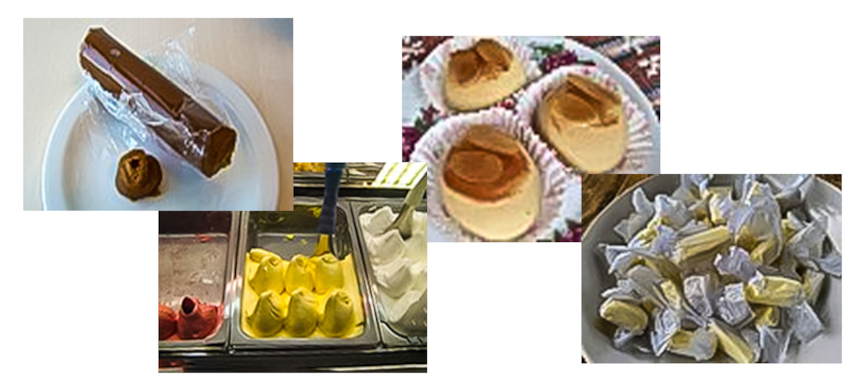
Cultivated for centuries at village level; commercialised since mid-20th century; Malaysian Ministry of Agriculture and Agro-based industry registered durian varieties from 1934, with ’D’ code numbering. With over 200 varieties registered – commonly known to durian connoisseurs; there are 13 favourite varieties known for colour quality, texture, aroma, taste, high yield and disease resistance.
Yes, we all know ‘Musang King’.
Most popular variety in Malaysia – Musang King (D197) – bright yellow flesh, strong aroma, some with ‘Xo’ after taste’. D24, renowned for its bitter-sweet taste; ‘Red Prawn’ (D175) with thick, softer flesh, sweet taste.
Where can you eat Durian?
In season, you can find durian stalls along roadside as you travel around Malaysia. You can also find them opened, packed, shrink-wrapped in trays ready for sale in some supermarkets.
Best place to eat durian is at source of origin – durian plantations dotted all over Malaysia.
Penang Island offers unique range of durian varieties due to climate and terrain. Grown almost exclusively on Penang Island’s east coast, durian plantations serve up their offerings along roadside stalls when fruit is in season.
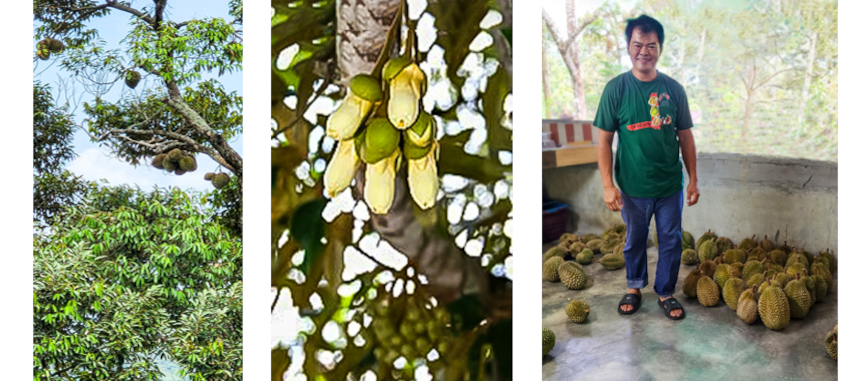
One such plantation is Rumah Batu (Stone House) in Balik Pulau. Owners Madam Ooi and Ah Hoe – 3 generations of durian farmers. Rumah Batu offers clean, cozy dining facility perched against hillside, overlooking 180 degrees of durian trees, where you can sit, enjoy magnificent views whilst sampling durian offerings. Chat to Ah Hoe on your favourite types of durian fruit … let him introduce you to sensational varieties grown in his plantation – you will not be disappointed …
There is a buffet to be enjoyed !
Start with subtle, clean flavours and finish with robust, rich creamy, Xo after taste ! Range is infinite and impossible to complete in one sitting !
Susu variety for starters – light yellow flesh, light tasting, slightly sweetish …
604 variety – rich yellow, medium thickness flesh, firm yet creamy, slightly bittersweet in finish …
New variety, ‘Ang Bak Kia’ (ABK) – rich yellow flesh, creamy-custard texture, honey-dew melon to honey in taste, slight bittersweet after taste …
What is not to like … if you appreciate durians ?
Simply unforgettable experience – like WOW !
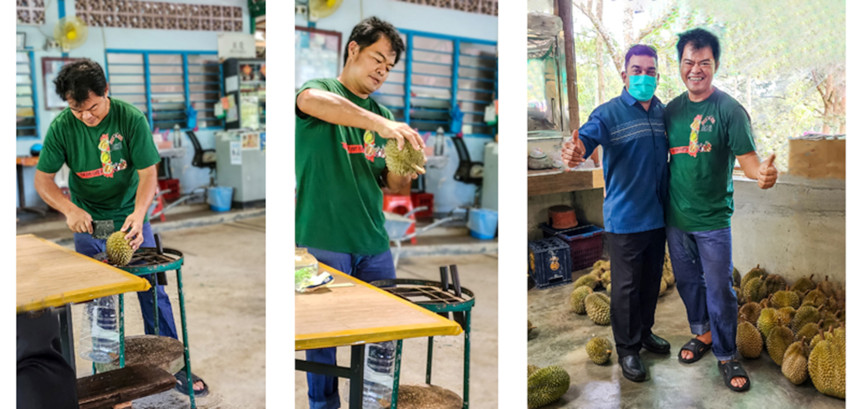
Ah Hoe is passionate about his plantation – fully organic farm, about 20 varieties in harvest on 35 varieties planted, about 200 trees. Some trees are 80-90 years old; employing 5-6 fulltime workers. Hilly terrain, little machinery used; labour intensive processes to cultivate and harvest; strings tied to fruits, nets surrounding trees to capture fallen fruits.
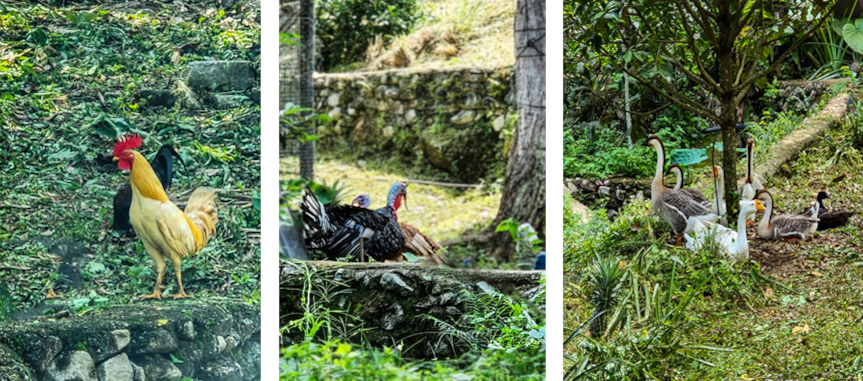
Being a natural product, harvest is unpredictable; hence rambutans, mangosteen, chempedak, nangka, nutmeg and stingless bees for honey supplement plantation earnings. Yearly output is largely dependent on natural rainfall at right time of year, winds, sunny days – hence it’s wise to have variety of fruits alongside poultry (chickens, geese and turkey) to not only supplement income but provide natural fertilisers for plantation. Good mix of Agro-animal husbandry !
How to get there
You can drive yourself to Rumah Batu 127, MK2, Sungai Pinang, 11010, Balik Pulau, Pulau Pinang, Malaysia or you can call Robert Williams, favourite driver-tour guide in Penang on +60 16 461 5725 to take you to plantation and provide you with sight-seeing commentary along the way. (Robert, Ah Hoe pictured above).
Definitely fun day not to be missed !
Conclusion
Durian is a sensational fruit … if you like it.
Durian is also a very tough business to be in – nurturing trees for at least 5 years without income, it is a labour of love and dedication. Uncertainty of annual output, victims to infestations, floods, droughts, foul weather.
Takes special kind of temperament to be durian farmer – passionate eyes, tender hold of fruits, nurturing nature.
Pleasure to have met and known Ah Hoe; even more delighted to have sampled his durians !
